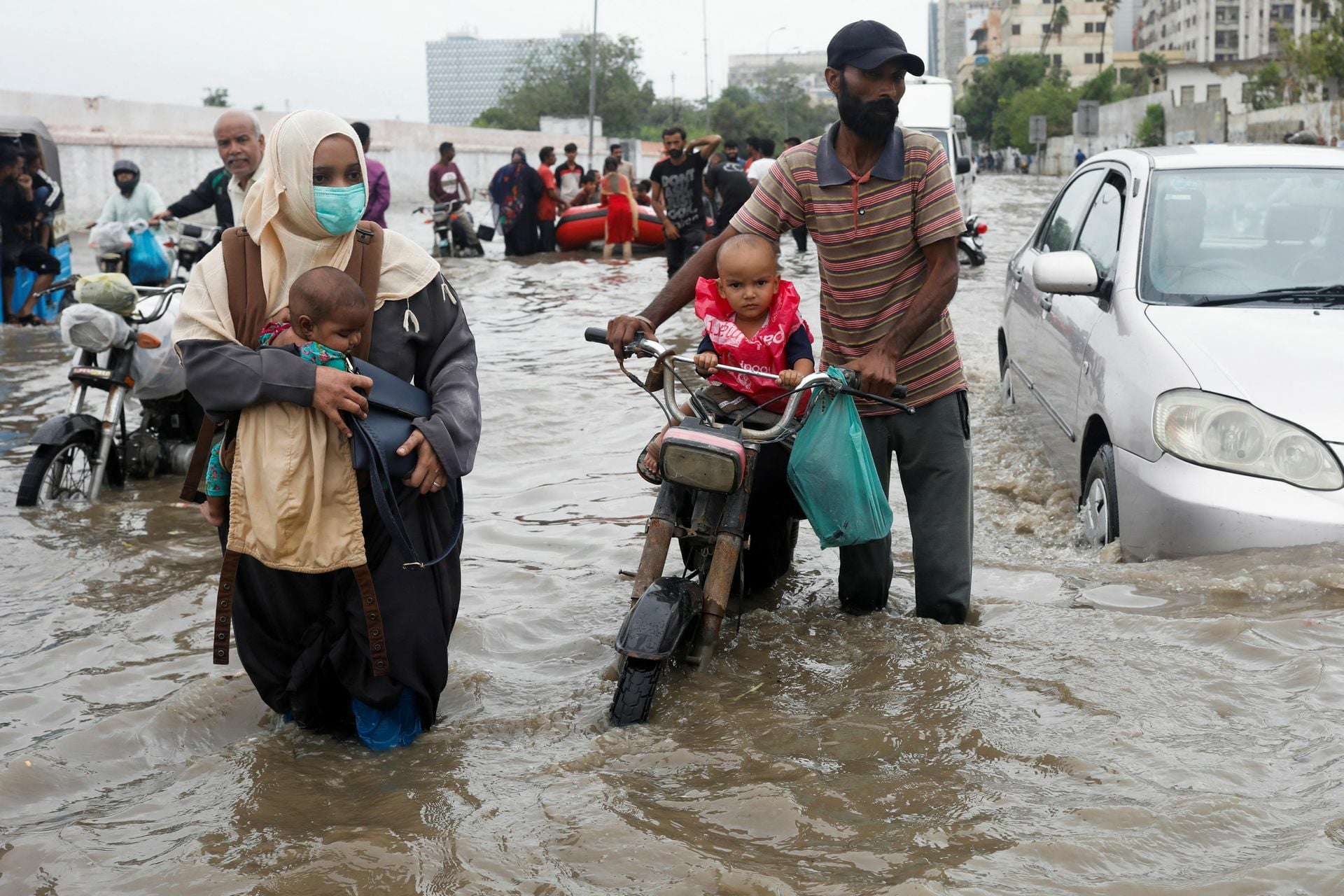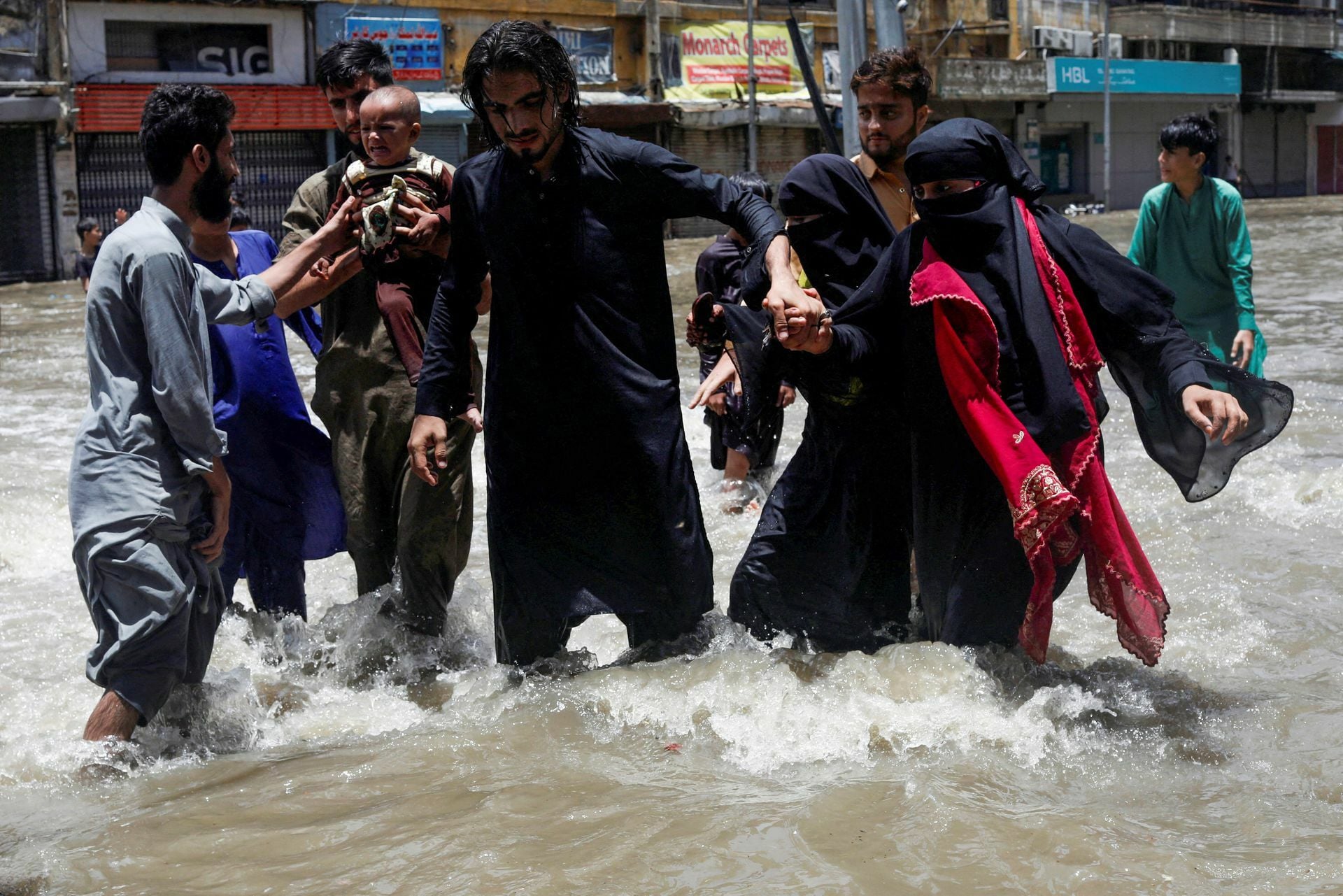July 13, 2022
ISLAMABAD – For the past several years now, R* braces for the monsoon season that hits Karachi between June and August by fortifying his home in PECHS Block 6 against the expected downpour. Almost every year, the fortifications prove meaningless and his home invariably floods from the gushing water flowing in from Mahmood Husain Road.
The last time his home was completely inundated was in August 2020, when he had to vacate his elderly mother, wife and children and take refuge in a nearby guesthouse. It was days before he could return home — or what was left of it. The furniture had been completely destroyed, as had his children’s wardrobes, several important documents, besides the doors and walls of the house. Replacing all these items and refurbishing the house required copious sums of money, which he had to dish out quickly to make it seem “normal” for his traumatised family.

Residents commute through a flooded road during the monsoon season in Karachi on July 9, 2022. — Reuters
Two years on, he has found himself fleeing from the house again. In these last 24 months, nothing has changed. In fact, it has only gotten worse, he says. “People enjoy the rain on their balcony with a cup of coffee but for me and my family, we can only worry about how to save our little kids and valuables.”
Rain’s a pain
R’s is a story of millions of Karachiites, who, instead of looking forward to the rainy season as is the romanticised notion in popular fiction and movies, must seek refuge from the havoc it wreaks due to the city’s crumbling infrastructure. For years, authorities have pinned the blame on encroachments along the city’s age-old storm water drains. The solution, they kept saying, lay in removing these encroachments and making them wider.
And yet, two years of anti-encroachment drives that rendered thousands homeless could not save the city’s streets from flooding. To an outsider, the level of incompetence and apathy on display is nothing less than mind-numbing.
Y*, a Pakistani-origin Australian citizen, who is currently visiting relatives in Karachi, was caught completely off guard by the urban flooding and has been stranded at her hotel for the last two days. She was simply horrified by the level of paralysis in the city due to the downpour. “Had my relatives not been here, I would not have come to Karachi to see all this”.

A family wades through a flooded road during the monsoon season in Karachi on July 9, 2022. — Reuters
For Y*, the disruption of traffic with 108 mm of rains in the city, supposed to be the industrial and commercial hub of Pakistan, is also quite incomprehensible. Images and footage of scores of motorists stuck on roads as the engines of their vehicles are stalled due to the accumulation of water up to a few feet is a manifestation of anti-people urban planning or complete lack of it.
Her only solace is that her misery is only temporary and she can soon return to a place that at least holds some regard for citizens’ rights and basic amenities. The millions of citizens who call Karachi home aren’t so lucky — most of all the thousands who sleep under the open sky every night.
When the sky’s the roof
A*, a daily wage labourer, who sleeps on the footpath under the Nagan Chowrangi underpass, is only such unfortunate soul. On Monday, he went to visit relatives in one of the societies at Scheme 33 off the Super Highway. Travelling back to the place he calls home later that night, he decided to take the M-9 motorway to get back into the city via the road connecting the airport. Little did he know that the water gushing downstream to the low-lying areas would leave him stranded for several hours.
But A* is used to this. Every monsoon, the underpass that he calls home floods, forcing him to stay up all night. “I lose out on a day’s earning the next day,” he lamented. “When it floods, me and the others who live in the underpass sometimes stand here all night with our belongings held over our heads,” he added.
Over at R’s home, the family is considering selling their home and moving to a locality that is relatively safer from the flooding. The annual ritual of evacuations and rebuilding, without any support from the authorities, has simply become unbearable.

A family wades through a flooded street during the monsoon season in Karachi on July 11, 2022. — Reuters
Each year is the same — authorities pretend to swing into action once the media highlights the damage caused by the rain. Once the water recedes, it is assumed that those who were displaced simply come back to their homes and everyone lives happily ever after.
This narrative may seem comforting, but unfortunately also quite far from the reality. Flooding constitutes, and increasingly so with climate change, a long-term issue reinforcing the vulnerability of successively displaced households who have to cope with it on a daily basis. The displacement is never defined, quantified and hence discussed in official documents and planning exercises.
Amid all this, the real estate developers make a killing from the sale and purchase of properties due to displacements and usually have their heyday in the post-urban flooding period.
A way forward?
Karachi, in its current state, will continue to flood no matter how many thousands are displaced in the name of anti-encroachment drives.
For instance, the storm water drains of North Nazimabad and other areas have been converted into sewers, the road infrastructure of Sharae Faisal is not only a blockade to steady water flow to the Manzoor Colony nullah, it also builds pressure in the low lying areas of Block 6. The sporadic dumping of municipal waste, by formal and informal sectors, along the Gujjar Nullah causes the narrowing of the channel.
The encroachments on the outfalls of the city were not made by its poor and yet, the lower middle class and the poor have suffered the most from urban flooding. Piecemeal and segmental solutions of the composite problem of urban flooding will further aggravate the situation — again to the disadvantage of the residents.

A man with a baby sits on a bench while children play in a flooded street during the monsoon season in Karachi on July 11, 2022. — Reuters
What is needed is an overhaul of the city’s storm water drainage system, keeping into account its burgeoning population and settlements.
The three segments — civil society, political leaders and academics — need to together handle the tall agenda of urban flooding.
The sooner they are able to do it the better, as the fate of the people is hinged upon the actions of these three sectors. The first thing is to make policymakers and power structures understand that demographic changes, climatic changes, direction of development interventions and disasters are inseparable entities and have a symbiotic relationship amongst them.
Any engineering solutions to the problem of urban flooding need to be human-centred, pro-people and as per the social realities of housing and affiliated issues of the city’s residents. Otherwise, Karachi will continue to flood again … and again … and again.


